
El Morro has served San Juan for centuries
SAN JUAN, P.R. — Inside the Santa Bárbara Battery of Fort San Felipe del Morro, more commonly known as El Morro, a fragment of a U.S. artillery shell can be seen lodged in the domed ceiling of an old tower.
While the fragment, fired during the Spanish-American War by U.S. Navy ships, is from 1898, the tower it lodged itself in dates back to 1539. It is the oldest structure of a fort that was expanded and used over the course of almost 400 years, until it was placed under the care of the National Park Service in 1961.
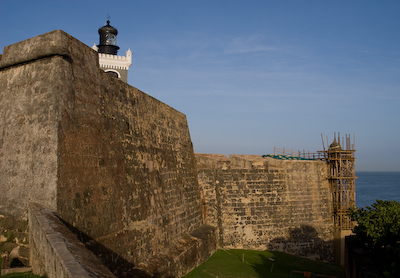 |
The impressive walls of El Morro at San Juan National Historic Site (Photo by Vincent Daniello). |
“The tower is medieval, the dome is Renaissance [style] and the fragment of the shell is [from] 1898, the Spanish-American War,” explained Carlos Almodóvar, one of the park ranger and interpreters at the San Juan National Historic Site. He is considered by his fellow interpreters to be the history expert of the group.
“There is no other place in the National Park Service, or the U.S., that can include those three original features,” said Almodóvar.
During its time of usage, El Morro was one of the most imposing and impressive forts in the New World. Its efficiency as a line of defense was extremely crucial not only to San Juan, but to the Spanish Empire that ruled over the island of Puerto Rico and much of the Caribbean for a sizeable amount of the past 500 years.
Fortification of San Juan
The position of Puerto Rico at the east end of the Caribbean made it an entry port for much of colonial Latin America. By the early 1500s, the Spanish had already conquered what are now Mexico and Peru and found them to be abundant in gold and other treasure. After mining these new acquisitions for precious metals and gems, they sent them back to Spain on galleons.
In order to protect these ships from enemies such as the English, French and Dutch, the Spanish Crown began ordering the building of fortifications at the important ports along the trade route. San Juan was not necessarily an important stop for commerce, but by being the first Spanish port that encountered ships, friendly or otherwise, entering the Caribbean, it was in dire need of being fortified.
| Cannon balls are stacked on the top level of El Morro at San Juan National Historic Site (Staff photo). |
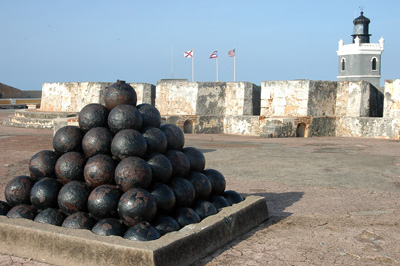 |
With rocky shorelines near its harbor, the city was at an advantage for defending against attacks from the sea. Even more advantageous, however, was the steep, pointed cliff on one side of the only entrance into San Juan Harbor. “El Morro” is Spanish for “The Headland,” which can be viewed as its Spanish builders understanding how much the fort is supported by the natural topography it rests on.
Still, the fort obviously did not start out as the 145-foot tall marvel seen today. The initial structure only consisted of a masonry tower and a water battery, a platform at the bottom and near the water. Three cannons were placed there, but it involved some trial-and-error.
“The cannons and gunpowder were invented before, but the Spanish were just getting them by that time,” said Almodóvar.
The Spanish had attempted to fire cannons from within the domed, enclosed tower, only to discover that the resulting noise and smoke filling the room was too much for gunners to bear. This learning process would repeat itself over the years, as the fort would improve and expand after both attacks and the discovery of weaknesses.
At this time, El Morro was designed to only repel against attacks from sea and to prevent ships from entering San Juan Harbor.
El Morro’s First Additions and Attack
With the rising fear of enemy ships landing and pillaging Spanish settlements, King Philip II of Spain ordered two men, military veteran Juan de Tejeda and Italian engineer Juan Bautista Antonelli, to investigate which ports in the New World required extra protection. San Juan was one of these ports, and in 1589, Tejeda and Antonelli returned there with a main design to turn the tower at El Morro into a fort.
| A guardhouse at the entrance of El Morro. The lighthouse rises in the background (Staff photo). |
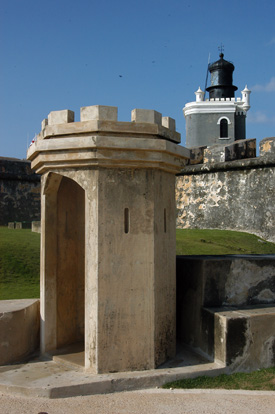 |
The main additions were a hornwork, two half-bastions connected by a wall, on the landside portion of the tower, along with a moat to give extra height to the walls and a drawbridge. These bastions are now known as Austria and Ochoa Bastion and make the sixth level of the fort that rises over visitors as they walk toward the entrance.
The first true test of El Morro’s capabilities came from an attack by Sir Francis Drake, a privateer for the British that was hailed in his home country as a hero. In Spain, however, Drake’s exploits of looting cities in the Caribbean and his role in defeating the Spanish Armada made him a pirate whose name was used to scare children.
In 1595, Drake and his ships attempted to enter San Juan Harbor in order to conquer the city and make it a permanent English base. Word of such an attack had reached San Juan beforehand and the city was well prepared when Drake arrived.
One of Drake’s largest mistakes was attempting to attack El Morro head on from the sea. After being defeated by El Morro’s defenses and San Juan’s planning, His fleet was forced to retreat, and he died of dysentery the next year.
One of the main reasons El Morro was so successful against attacks from the sea over the years was its system of multi-level cannons. The current design, in fact, resembles the front of a battleship.
“What it’s doing is sort of imitating or mirroring the aggressor, which are tall, skinny ships,” said Juliana Smith, a SJNHS interpreter working at El Morro.
“So what the Spaniards are doing [is that] they’re putting cannons on all the six different levels to shoot different parts of the ship. Simple as that.”
But despite its strength against sea attacks, El Morro was, at the time after Drake’s attack, not as well protected from attacks coming from the land behind it.
El Morro Captured
Merely three years after Drake’s attack, the English returned, led by Sir George Clifford, the Third Earl of Cumberland. It was this attack that proved to be the only one to ever break through and capture El Morro.
|
The only entrance leading down to El Morro’s original 1539 guard tower that was once the only defense protecting San Juan Harbor (Photo by Rene Basulto). |
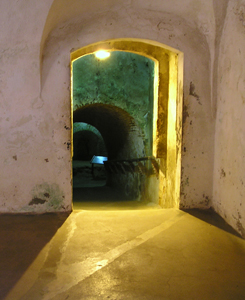 |
“The first attack was with Drake, [and it] was from the front and was unsuccessful,” said Almodóvar.
“But after the first attack, the enemy tried from the back, because they learned the lesson there.”
In addition to Cumberland realizing the advantage of a land attack, the troops that had been present from Drake’s attack were now non-existent after having only been brought to protect a treasure ship that had been forced to dock at San Juan. This left the city with around only 300 troops, including volunteers, a number that dropped over the years due to famine and disease to around 150.
By the time Cumberland arrived from the east end of San Juan, he and his 1,700 men found the land bridge ill-protected, and Spanish deserters were quick to point out how to take El Morro by siege and how to prevent supplies from reaching the fort’s around 80 defenders.
This victory would be short-lived, however, as the same dysentery that had crippled the Spanish troops spread to Cumberland’s men, incapacitating 400 of them and killing another 400. They left just a few weeks after taking El Morro, but pillaged and destroyed the city just before their departure.
In the wake of the attack, Spain sent more soldiers, supplies and weapons to rebuild the city and its defenses. From 1601 to 1609, the reconstruction of El Morro saw its toppled hornwork strengthened with the foundations still used today. A small fort now known as El Cañuelo was built at the opposite end of the San Juan Harbor entrance in order to work in tandem with El Morro’s guns to create crossfire to deter invading enemy ships.
The Dutch Attack
Still, the next attack came quickly in 1625, this time from the Dutch led by Boudewijn Hendricksz. They attacked from the sea at first, and were able to anchor within San Juan Harbor and mount a siege against El Morro from the landside.
Luckily, the time gap between their anchoring and landfall allowed for the citizens to flee into the woods in the east and for El Morro to be stocked up on volunteers and supplies.
While the city was easily taken due to the lack of resistance, the siege on El Morro lasted 21 days, with many of the Dutch troops being killed. In desperation, Hendricksz threatened to burn the town if there was no surrender.
“We have enough courage and wood and stone to build again,” responded Governor Juan de Haro, who was holed up inside the fort.
The Dutch did indeed burn all of San Juan to the ground, but the city was eventually won back and the enemy was driven out. After this attack, the 1600s were a peaceful time for Puerto Rico. Construction on the city walls enclosing San Juan began in 1634 and was finished in 1678. Around this time, the original tower of El Morro was also covered over in a U-shaped battery.
“Defense of the First Order”
In 1765, though, a tremendous boom of construction and refortification began in San Juan. King Charles III declared the city a “Defense of the First Order” after receiving a report from Field Marshall Alexander O’Reilly on the strategic importance of Puerto Rico. O’ Reilly and Royal Engineer Thomas O’Daly, another Irish-born Spanish soldier, set about both restructuring the troops in San Juan and strengthening its defenses.
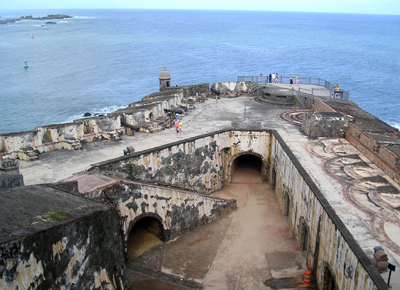 |
Santa Barbara Battery overlooking the only entrance into San Juan Harbor (Photo by Rene Basulto). |
San Cristóbal Hill was once the location of just a small platform for cannons. It was eventually carved out to build the Fort San Cristóbal seen today, meant to defend from land attacks just as strongly as El Morro had defended the sea.
El Morro was also transformed into its current six-level form. The battery that covered the original second-level tower was expanded into the fourth- level Santa Bárbara Battery and its number of cannons nearly tripled from 11 in the 1600s to around 37 in the 1780s. The casemate battery, now covered in grass and inaccessible, was the third level, and the Carmen Battery, the fifth level, was built to both support the Santa Bárbara Battery and protect both the western and eastern parts of San Juan.
The most significant improvement, however, was the addition of a tremendous wall behind the Santa Bárbara Battery. It provided a level of cannon fire equal in height to the Carmen Battery at the San Juan Harbor entrance, and also shielded the sixth-level improved hornwork and its bastions that fired towards the esplanade on the landside entrance.
Both forts were completed in the early 1790s, just in time for another attack by British forces from the land in 1797. However, this attack never reached El Morro, as the rest of the city was now so well protected.
For 101 years afterwards, El Morro and the rest of San Juan saw no military action against them.
Spanish-American War
Then, in 1898, a U.S. Navy ship fired on El Morro and San Juan during the Spanish-American War. The three-hour bombing destroyed parts of the walls and the lighthouse on the Ochoa Bastion built in 1876.
This would be the final attack on El Morro as the United States took control of Puerto Rico at the end of the war. El Morro became a part of the Navy’s Fort Brooke complex, and the U.S. still saw fit to improve even more on the fort.
The lighthouse was rebuilt in 1906 and, during World War II, a bunker was placed near the entrance and an observation post meant to detect German U-boats was built into part of the main wall near the Carmen Battery.
After all of the rebuilding, modifications and improvements made on El Morro over the course of 400 years, the fort still stands as imposing as when it was used to defend San Juan.
“This was built to create an impression, an intimidation [to say to people] ‘You stay away. This is my entrance, this is my domain, you are entering my land, so stay away.’” said Almodóvar.
Now, as a part of the San Juan National Historic Site, El Morro almost quite the opposite, attracting visitors to be in awe of its grand stature.
If You Go
- Fort San Felipe del Morro is open every day of the week from 9 a.m. to 5 p.m. from June to November, and 9 a.m. to 6 p.m. from December to May.
- Admission for adults ages 16 and older is $3 for El Morro, with a ticket being valid for 24 hours; or $5 for both forts, with a ticket being valid for seven days.
- Children ages 15 and under can enter the fort free of charge.
- If you are arriving from the piers, there is a trolley that runs, free of charge, to all of the attractions, including stops in front of the walkway to El Morro and the fort itself. Its stop near the piers is in front of Pier 2 on La Marina Street. Taxi cabs are also available from this area.
- To reach El Morro from the cruise ship piers by walking, go to west on St. Marina Street until you reach the end, and then go up the road and make a left onto Comerico Street. Take the first right you see and go north up San Justo Street. Walk all the way up San Justo Street, and once it ends, go west (left) on Norzagaray Street. You will see El Morro on your right around where the street ends.
- In a car, from Luis Muñoz Marín International Airport: Take Exit 26 (Baldorioty de Castro Avenue) going west. Take exit 25 (Muñoz Rivera Avenue) until you reach Old San Juan. To reach El Morro, continue on Muñoz Rivera Avenue and make a right onto Norzagaray Street. Continue on this street, then make a left onto Morovis Street, where there is underground parking on your left.
- Please be aware that driving in Old San Juan is not recommended due to very narrow streets and fairly limited parking.

Comments are Closed